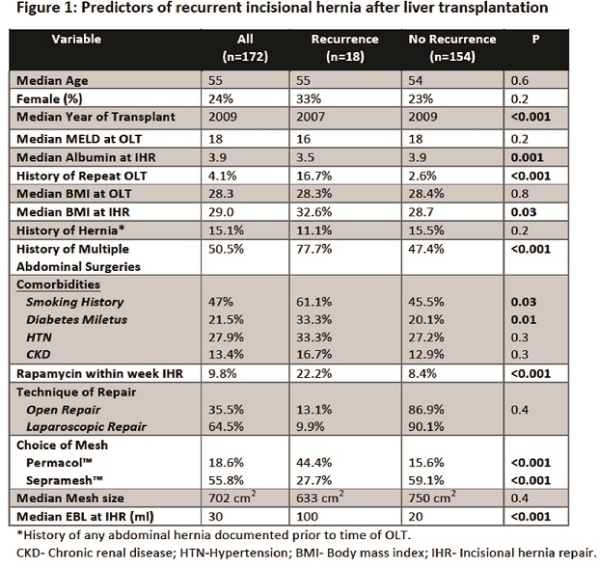Preventing Recurrence of Incisional Hernia after Liver Transplantation
Transplant Surgery, Indiana University, Indianapolis, IN.
Meeting: 2018 American Transplant Congress
Abstract number: D257
Keywords: Adverse effects, Liver transplantation, Weight
Session Information
Session Name: Poster Session D: Surgical Issues (Open, Minimally Invasive): All Organs
Session Type: Poster Session
Date: Tuesday, June 5, 2018
Session Time: 6:00pm-7:00pm
 Presentation Time: 6:00pm-7:00pm
Presentation Time: 6:00pm-7:00pm
Location: Hall 4EF
Background: Incisional hernia is a well-known complication of orthotopic liver transplantation (OLT). Although factors that affect incidence of hernia after OLT have been described, recurrence of hernia after initial repair has not previously been investigated in this population. Methods We conducted a retrospective review upon a series of 172 adult patients undergoing incisional hernia repair (IHR) after orthotopic liver transplant (OLT) at a single center between the years 2005 and 2016. Primary endpoint was recurrence, secondary endpoints were postoperative morbidity, mortality and length of stay. Results were stratified by demographic, intraoperative, and postoperative variables. Results: Of 1,954 patients undergoing OLT, 172 patients (11.3%) who underwent IHR were identified with a median follow-up of 47 months, (range 12-128). Mortality was 3/172 (1.7%), each attributed to postoperative cardiac events. Recurrence was experienced by 18/172 patients (10.4%). Median time to recurrence was 19.5 months. Recurrence was significantly associated with lower albumin levels at time of hernia repair (median 3.9 vs 3.5 p=0.001). Smoking history, diabetes mellitus, primary graft failure, and the use of rapamycin within one week of IHR were significantly associated with recurrent hernias (Figure 1). The use of a mesh with biologic component was also associated with a higher recurrence rate (5.2% vs 12.7% p= 0.001). Laparoscopic approach was not associated with increased recurrence (p=0.4). Conclusions: We offer the largest published series of incisional hernia repairs performed after OLT. In this population, incisional hernia repair is a relatively late complication. Patients with multiple liver grafts represent the highest risk for recurrence. Rapamycin should be stopped prior to IHR. Special attention should be afforded to choice of mesh, and preoperative nutritional supplementation as each may affect durability of repair.
CITATION INFORMATION: Butler J., O'Brien D., Kays J., Kubal C., Ekser B., Fridell J., Mangus R., Powelson J. Preventing Recurrence of Incisional Hernia after Liver Transplantation Am J Transplant. 2017;17 (suppl 3).
To cite this abstract in AMA style:
Butler J, O'Brien D, Kays J, Kubal C, Ekser B, Fridell J, Mangus R, Powelson J. Preventing Recurrence of Incisional Hernia after Liver Transplantation [abstract]. https://atcmeetingabstracts.com/abstract/preventing-recurrence-of-incisional-hernia-after-liver-transplantation/. Accessed January 6, 2026.« Back to 2018 American Transplant Congress

